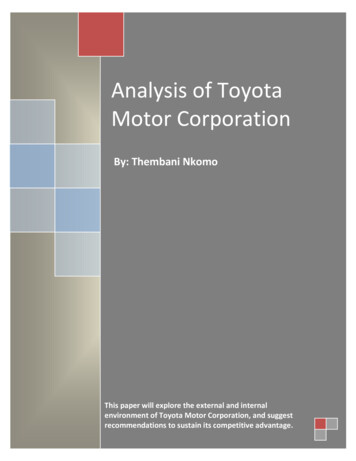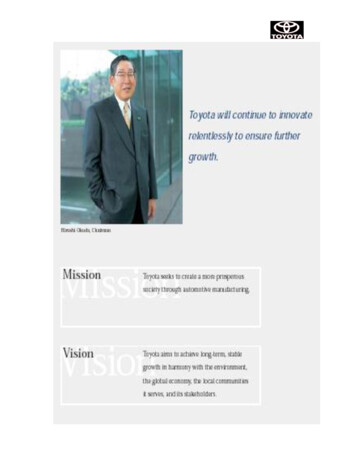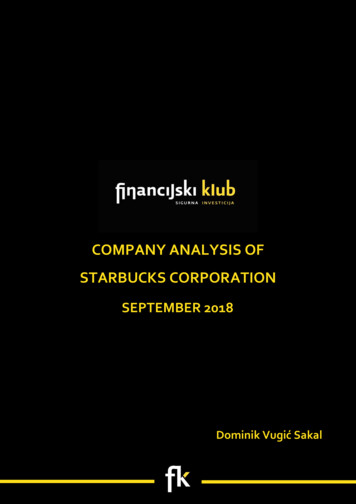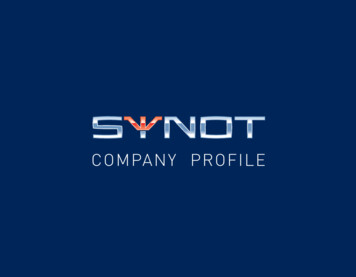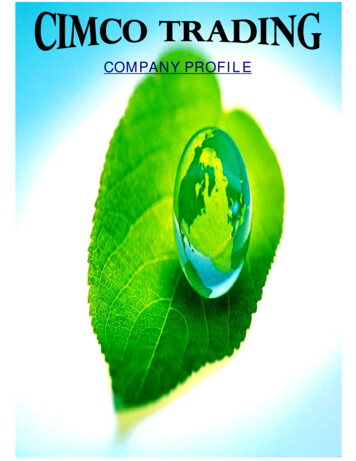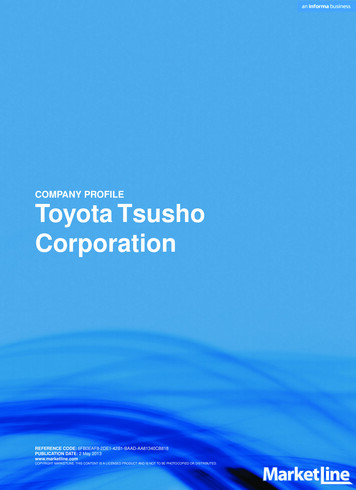
Transcription
COMPANY PROFILEToyota TsushoCorporationREFERENCE CODE: 6FB0EAF8-2DE1-42B1-BAAD-AA81340CB818PUBLICATION DATE: 2 May 2013www.marketline.comCOPYRIGHT MARKETLINE. THIS CONTENT IS A LICENSED PRODUCT AND IS NOT TO BE PHOTOCOPIED OR DISTRIBUTED.
Toyota Tsusho CorporationTABLE OF CONTENTSTABLE OF CONTENTSCompany Overview.3Key Facts.3SWOT Analysis.4Toyota Tsusho Corporation MarketLinePage 2
Toyota Tsusho CorporationCompany OverviewCOMPANY OVERVIEWToyota Tsusho Corporation (Toyota Tsusho or “the company”) is a general trading company whichtrades products such as metals, machinery, electronics, automotive parts, chemicals, foodstuffs,consumer products and services. The company operates in Japan, Asia, Oceania, North Americaand Europe. It is headquartered in Nagoya, Japan and employed 33,845 people as of March 31,2012.The company recorded revenues of JPY5,916,759 million ( 74,965.3 million) during the financialyear ended March 2012 (FY2012), an increase of 3% over FY2011. The operating profit of thecompany was JPY92,403 million ( 1,170.7 million) in FY2012, an increase of 8.3% over FY2011.Its net profit was JPY66,205 million ( 838.8 million) in FY2012, an increase of 40.4% over FY2011.KEY FACTSHead OfficeToyota Tsusho Corporation9-8 Meieki 4-chomeNakamura-kuNagoya 450 8575JPNPhone81 52 584 5011Fax81 52 584 5659Web Addresshttp://www.toyota-tsusho.com/Revenue / turnover 5,916,759.0(JPY Mn)Financial Year EndMarchEmployees33,845Tokyo Ticker8015Toyota Tsusho Corporation MarketLinePage 3
Toyota Tsusho CorporationSWOT AnalysisSWOT ANALYSISToyota Tsusho is a general trading company which trades products such as metals, machinery,electronics, automotive, chemicals, foodstuffs, consumer products and services. The company hasa diversified product portfolio, which not only provide protection against unfavorable forces in specificsector but also enable it to benefit from opportunities available in various sectors. However, intensecompetition may eventually have an adverse impact on the financial position and results of operationsof Toyota Tsusho.StrengthsWeaknessesDiversified product portfolioStrong global networkRobust growth in the financial performancePoor allocation of resources as comparedto peersHeavy dependence on Toyota andconcentrated operationsOpportunitiesThreatsDevelopment of the bio-plastics supplychainStrengthening of energy business throughacquisitions and joint venturesRecovery of global automobiles industryExpanding presence in the growing iodinemarketIntense competitionEnvironmental regulationsRisk of natural disastersStrengthsDiversified product portfolioToyota Tsusho has a diversified product portfolio. The company trades a wide range of products,including metals such as steel and aluminum, machinery and electronics, energy and chemicals,and various consumer products. The metals segment manufactures, processes, sells and disposesvarious products, including ordinary and special steel products, steel construction materials, unwroughtnonferrous and precious metals. The machinery, energy and project segment provides machinetools, industrial machinery, textile machinery, testing and measuring instruments, electronic machinery,environmental equipment, industrial vehicles and construction machinery.The chemicals and electronics segment processes, manufactures and sells communications devices,electronic devices, semiconductors, automotive embedded software development, electronicToyota Tsusho Corporation MarketLinePage 4
Toyota Tsusho CorporationSWOT Analysisequipment, network integration and support, PCs, PC peripherals and software, component partsfor automobile production and ITS (Intelligent Transport Systems) equipment.The automotive segment primarily provides passenger vehicles, commercial vehicles, light vehicles,two-wheeled vehicles, trucks and buses, and automotive parts. The global production parts andlogistics division manufactures, processes and sells automotive parts. The segment also operatesa logistics business and a tire assembly business.The produce and foodstuffs segment manufactures,processes and sells livestock feed, grains, processed foods, food ingredients, agricultural products,marine products, livestock products, and alcoholic beverages.Additionally, the consumer products, services and materials segment handles condominiums,commercial buildings, construction materials, housing materials and furniture. The segment alsodeals with textile raw materials, apparel, interior goods, sleepwear products, textile products, textilematerials, jewelry, automotive interior parts, packaging materials, and paper and pulp products.Hence, diversified business operations not only provide protection against unfavorable forces inspecific sector but also enable it to benefit from opportunities available in various sectors.Strong global networkThe company has a strong global network. Toyota Tsusho operates through a network of 485subsidiaries, and 238 affiliates in more than 60 countries. It has presence in Japan, Asia, Oceania,North America, Central and South America, Europe, Russia, Africa, Middle East, and in many otherregions of the world. Moreover, for the supply of parts to overseas automobile production units, thecompany has established logistics bases globally. The automotive segment sells automobiles andautomobile parts to about 150 countries worldwide. The automotive segment is engaged in directsales of vehicles and spare parts, as well as provision of services, to customers through a consolidatedretail network of more than 172 sales outlets globally. In addition, the company plans to expand itsdealership network in China, Russia, Africa, Australia, Asia and Oceania. Thus, the company's strongglobal network provides a robust platform for the optimum transfer of goods, funds, and information.It also helps the company to increase its earnings and gain competitive advantage over its peers.Robust growth in the financial performanceThe company witnessed a significant growth in its financial base in the past year. Toyota Tsushohas witnessed a consistent decline in its revenues and profits from 2007 to 2010 due to the economicslowdown. However, the company's performance has improved significantly in the past few yearslargely due to improvement in market conditions and an increase in automobile sales volumes. Forinstance, the company revenues grew by 3% in FY2012 as compared to FY2011 to recordJPY5,916,759 million ( 74,965.3 million). Similarly, Toyota Tsusho's operating profit and net profitalso increased considerably in FY2012. The operating profit of the company grew by 8.3% toJPY92,403 million ( 1,170.7 million), while the net profit increased by 40.4% to JPY66,205 million( 838.8 million). As a result of this, Toyota Tsusho's operating margins also increased. The company'soperating profit margin increased from 1.5% in FY2011 to 1.6% in FY2012 and the net profit marginincreased from 0.8% in FY2011 to 1.1% in FY2012. Thus, strong financial performance providesToyota Tsusho Corporation MarketLinePage 5
Toyota Tsusho CorporationSWOT Analysisfinancial stability to the company, which could then be leveraged to seek growth avenues in thefuture.WeaknessesPoor allocation of resources as compared to peersThe company has low return on equity (ROE) and return on assets (ROA) compared to its peercompanies. The company's competitors such as Marubeni Corporation and ITOCHU Corporationhave more ROE when compared to Toyota Tsusho. Marubeni Corporation's ROE was 18.8% andITOCHU Corporation's ROE was 17.7% during FY2012. In contrast, Toyota Tsusho's ROE was9.5% in FY2012. Lower ROE compared to its peers indicates that the company is not using theshareholders' money efficiently and that it is not generating high returns for its shareholders.Moreover, Marubeni Corporation and ITOCHU Corporation have more ROA when compared toToyota Tsusho. In FY2012, Marubeni Corporation's ROA was 3.3%, while ROA of ITOCHUCorporation was 4.6%. In contrast, the ROA of Toyota Tsusho was 2.4% in FY2012. Low ROAindicates that the company has been deploying its assets in an inefficient manner and indicates theinefficiency of the company's management towards allocation of resources compared to its peercompanies.Heavy dependence on Toyota and concentrated operationsThe company is largely dependent on few specific customers for a majority of its revenues. Themain business line of the company is the sale of automotive-related parts and other products in thedomestic and overseas markets. In FY2012 the company's sales to the Toyota Group accountedfor 13.6% of net sales, with sales to Toyota Motor representing 6% of net sales. Therefore, trendsin the automobile output of Toyota Motor’s may impact the operating results of Toyota Tsusho. Theloss of all or a substantial portion of sales to Toyota Group would cause the company to lose asignificant portion of its revenue and would lower its operating profit margin and cash flows fromoperations.Moreover, the company is dependent on Japan for a majority of its revenues. In FY2012, Japan,Toyota Tsusho's largest geographical market, accounted for 44.6% of the total revenues.Overdependence on one geographic region makes it susceptible to changes associated with theeconomic and political situation of the country.Therefore, dependence on a specific customer and concentrated operations could restrict thecompany's ability to conduct its operations in a flexible manner, thus affecting overall operationsand profitability.OpportunitiesToyota Tsusho Corporation MarketLinePage 6
Toyota Tsusho CorporationSWOT AnalysisDevelopment of the bio-plastics supply chainThe company has taken a number of strategic decisions in the recent past to develop the bio-plasticssupply chain. According to the company, as of FY2011, the annual demand worldwide for polyethyleneterephthalate (PET) was 53.2 million tons, representing a market worth JPY8,000 billion (approximately 81.5 billion). Furthermore, the demand for PET is growing at an annual rate of 8%, primarily drivenby demand from the emerging markets.In order to create a supply chain, the company signed an off-take agreement with Brazilian oilcompany Petroleo Brasileiro (Petrobras) for 1.4 million kiloliters of sugarcane-derived bioethanolannually over the next 10 years. As a second step, the company established a joint venture with aTaiwanese company to supply Bio-MEG (mono ethylene glycol) to PET manufacturers in Asia, whowill produce finished PET products. The company aims to produce and sell 200,000 tons of Bio-PETannually in 2012 and is targeting annual production of 1 million tons by 2015. The company plansto supply the finished PET products to Toyota for use in the interiors of some of its automobilemodels, and to other textile manufacturers and food manufacturers through collaboration with otherdivisions. Thus, the company’s ability to create a robust supply chain for the bio-plastics businessprovides a long-term growth opportunity.Strengthening of the energy business through acquisitions and joint venturesToyota Tsusho has been expanding its presence in the global energy business to boost long-termearnings. For instance, in April 2012, the company acquired a 32.5% interest in a coal bed methane(CBM) project from Encana, Canada-based natural gas producer. This project covers 480,000 acresin and around Wheatland County in Alberta, Canada and is Canada's largest CBM resource play.Over the seven-year development period, 1,500 wells are expected to be drilled and 1,600recompleted in order to increase the production volume. The peak production volume is expectedto be about 140 MMcf per day.Earlier in January 2012, the company increased its stake in wind and solar power projects companyEurus Energy to further expand its energy business. Similarly, in 2010, Toyota Tsusho purchaseda 45% interest in the Oyster Creek Cogeneration Plant in Texas, the US from GE Energy FinancialServices, a member of the General Electric group. Owned by an affiliate of GE Energy FinancialServices, the plant is located inside a Dow Chemical petrochemical complex. Thus, strategicacquisitions such as these would enable the company to strengthen its market position in the globalenergy sector, increase customer base, and generate incremental revenues.Recovery of the global automobiles industryThe global automotive industry was severely affected by the economic downturn, with a decline inrevenues being recorded in 2008 and 2009. However, 2011 saw a strong rebound which has continuedinto 2012. According to MarketLine (a unit of Informa plc), the global automotive manufacturingindustry grew by 8.9% in 2012 to reach a value of 1,563.9 billion. The cars segment was the largestsegment of the global automotive manufacturing industry, accounting for 55.9% of the industry'stotal value.Toyota Tsusho Corporation MarketLinePage 7
Toyota Tsusho CorporationSWOT AnalysisThe performance of the industry is forecast to accelerate, with an anticipated compound annualgrowth rate (CAGR) of 6.7% for the four-year period 2012-16, which is expected to drive the industryto a value of 2,025.4 billion by the end of 2016. Toyota Tsusho, through its automotive businesssegment, exports automobiles and automotive parts of the Toyota Group, including passenger carsof Toyota Motor and Daihatsu Motor, and trucks of Hino Motors, respectively manufactured in Japanby the Toyota Group. The recovery of global automotive industry thus provides Toyota Tsusho anopportunity to gain more customers and expand its revenues.Expanding presence in the growing iodine marketThe distribution of iodine resources across the globe is more imbalanced than rare e
SWOT ANALYSIS Toyota Tsusho is a general trading company which trades products such as metals, machinery, electronics, automotive, chemicals, foodstuffs, consumer products and services.The company has a div ersified product por tfolio , which not only pro vide protection against unf


